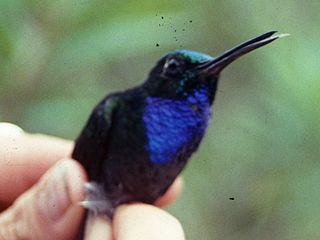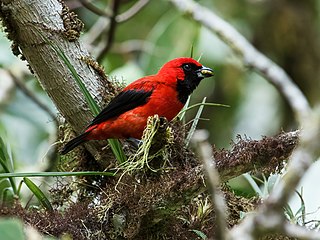
Otocinclus is a genus of catfish in the family Loricariidae native to South America, commonly known as "dwarf suckers" or "otos". This genus, like other loricariids, is characterized by rows of armour plating covering the body, as well as the underslung suckermouth. They are generally small in size; O. tapirape is the smallest of the species (2.4 cm), while O. flexilis is the biggest (5.5 cm). These species have adaptations that allow them to breathe air. A duct forms at the junction between the esophagus and the stomach and expands into an enlarged, ring-like diverticulum, characteristic of this genus, which allows air-breathing. Otocinclus are popular aquarium fish, and they are often purchased as algae eaters. It is difficult to breed them in captivity, and only wild caught Otocinclus are available to hobbyists. This genus is widely distributed east of the Andes of South America, throughout the lowlands from northern Venezuela to northern Argentina, but are generally absent from the Amazon and the Orinoco lowlands.

The zebra oto or tiger oto is a fish of the genus Otocinclus of the family Loricariidae that originates from Peru.

The Lucifer titi is a species of titi, a type of New World monkey, from South America. It is found in Brazil, Colombia, Ecuador, and Peru. It was described as Callicebus lucifer in 1914. The Lucifer titi has previously been treated as part of C. torquatus, the collared titi.

The buff-tailed sicklebill is a species of hermit hummingbird from the lower Andes and adjacent west Amazonian lowlands from southern Colombia and northern Ecuador to Peru and Bolivia.

The Napo sabrewing is a species of hummingbird in the family Trochilidae. It is found in Colombia, Ecuador, and Peru. Its natural habitat is subtropical or tropical moist montane forest. It is becoming rare due to habitat loss.
Microcaecilia albiceps is a species of caecilian in the family Siphonopidae. It is found in the Amazonian lowlands and slopes of the eastern Andes in Colombia and Ecuador, possibly extending into Loreto in Amazonian Peru.
Sphaenorhynchus carneus, the Napo lime treefrog, is a species of frog in the family Hylidae. It is found in the upper Amazon Basin in southern Colombia, Ecuador, Peru and in central Amazonia in Brazil. It might also occur in Bolivia.

The slate-colored hawk is a species of bird of prey in the family Accipitridae: the hawks, eagles, and allies.

The cobalt-winged parakeet is a species of bird in the family Psittacidae, the true parrots. It is found in the eastern Andean foothills, the far western Amazonian regions in Venezuela, Colombia, Ecuador, Peru, and Bolivia; and Brazil, in the Amazon Basin states of Amazonas, Acre, and Rondonia. Its natural habitats are subtropical or tropical, moist lowland forests and heavily degraded former forest.

The tui parakeet is a species of bird in the family Psittacidae, the true parrots. It is found in the Amazon Basin of Brazil, and Amazonian Peru and Bolivia; also a minor range into eastern Ecuador, and the river border of far south-eastern Colombia.

The cinnamon attila is a species of bird in the family Tyrannidae, the tyrant flycatchers. It is found in northern South America in the Amazon Basin of Brazil and the Guianas. It is found in Brazil, Colombia, Venezuela, Guyana, Suriname, and French Guiana; also Amazonian Ecuador, Peru, and regions of Bolivia. Its natural habitat is subtropical or tropical swamps.

The vermilion tanager is a species of Neotropical bird in the tanager family Thraupidae. It is the only member of the genus Calochaetes.

The chestnut-belted gnateater is a species of bird in the family Conopophagidae, the gnateaters. It is found in the Amazon Basin of northern Brazil, southern Colombia and eastern Peru and Ecuador; also the Guianan countries of Guyana, Suriname and eastern French Guiana. Its natural habitat is tropical moist lowland forest.

The violaceous jay is a species of bird in the family Corvidae, the crows and their allies.

The yellow-crowned elaenia is a species of bird in the family Tyrannidae, the tyrant flycatchers. It is found in eastern Orinoco Basin Venezuela, the Guianas, and along the Amazon River corridor; also Colombia, Brazil, Guyana, Suriname, French Guiana, Ecuador and Peru.

The pygmy antwren is a species of bird in the family Thamnophilidae, the antbirds. It is found in Bolivia, Brazil, Colombia, Ecuador, French Guiana, Guyana, Peru, Suriname, and Venezuela. Its natural habitats are subtropical or tropical moist lowland forests, subtropical or tropical swamps, and heavily degraded former forest.

The black-necked red cotinga is a species of bird in the family Cotingidae, the cotingas.

The white-shouldered antshrike is a species of bird in the family Thamnophilidae. It is found in Bolivia, Brazil, Colombia, Ecuador, Peru, and Venezuela. Its natural habitat is subtropical or tropical moist lowland forests.

The lemon-throated barbet is a species of bird in the New World barbet family Capitonidae. It is found in Bolivia, Brazil, Colombia, Ecuador, and Peru.

The Napo moist forests (NT0142) is an ecoregion in the western Amazon rainforest of Colombia, Ecuador and Peru.


















